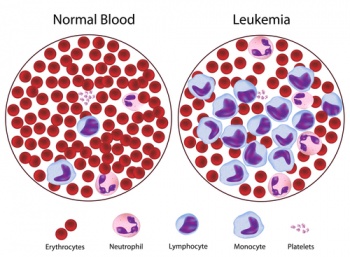Leukemia
Leukemia is a subgroup of Cancer referring to diseases affecting the blood or bone marrow. Up to 90% of leukemias affect adults, but leukemia is still the most common malignancy in childhood – it is responsible for nearly 1/3 of malignancies diagnosed in children. Overall, the most common type of leukemia is Chronic Lymphocytic Leukemia, with an incidence of 30 per million per year.
| Causes | Environmental Toxins, Radiation, Electromagnetic Fields, |
|---|---|
| See Also | Women's Health, Oncology |
| Books | Books on Women's Health, Books on Oncology |
| Articles | Articles on Women's Health, Articles on Oncology (Cancer) |
Contents
Naturopathic Assessment
Causal Factors
In order to stimulate the innate ability of the body to heal the causes of disease must be identified and addressed. Leukemia is a variable disease with several different predisposing factors, which are outlined below.
External
- Radiation
- Exposure to ionizing radiation causing chromosomal damage has been linked to leukemia.[1]
- Electromagnetic Fields
- An association between elevated residential electromagnetic field exposure and childhood leukemias has been identified, this is still controversial.[2]
Environmental
- Socioeconomic Environment
- Individuals with higher socioeconomic standing, and social isolation are at increased risk of leukemia. It is hypothesized that this may be due to under exposure or abnormally late exposure to common infections and immune stimulants.[2]
- Environmental toxins such as cadmium are associated with an increased risk of leukemia.
Genetics
- Genetic Disorders
- There is an increased risk of leukemia in several genetic disorders including trisomy 21 (Down’s syndrome), monosomy 7, and neurofibromatosis type 1.[3]
- Gestational Factors
- Gestational factors involve prenatal exposure to radiation. The impact this prenatal exposure to radiation may have on leukemia risk factor is still being studied and there is no agreement on the quantification of risk. [3]
Physiology
Symptoms
Signs and symptoms of leukemia include:[2]
- Anemia
- Splenomegaly
- Bone Pain
- Arthralgia
Diagnostic Tests
The following diagnostic tests may be used to identify and evaluate leukemias. Once suspected, it is important to quickly establish the type of leukemia in order to immediately start therapy.
- Blood tests that are often requested included the complete blood count, a DIC screen, Chemistry profile, and HLA typing. Follow up tests may include bone marrow aspirate, bone marrow biopsy, PCR, or FISH to identify the type of leukemia and appropriate treatment.[4]
Naturopathic Treatment Strategy
The goal of naturopathic treatment is to support and work in tandem with the healing power of the body. A treatment strategy is the most effective when it addresses the underlying causal factors and when it follows the naturopathic therapeutic order. The treatment strategy for leukemia is to support conventional treatments and to improve overall quality of life.
It is always advisable to work with a naturopathic doctor before engaging in any treatment plan.
Prevention
Prevention involves addressing any of the causal factors before they cause cancer, for example:
Cancer Specific Treatments
Follow the general guidelines for cancer specific treatments. Additional treatments that are specific to leukemia include:
- Dietary recommendations include:
.
- Supplementation
- Vitamins such as:[1] Vitamin A, Vitamin C, Vitamin E, Vitamin D, Vitamin K, Vitamin B12,
- Minerals such as:
- Amino Acids such as:
- Food Supplements such as
Supportive Care
Follow the general guidelines for supportive care especially when conventional treatments such as surgery or radiation therapy are chosen.
References
- ↑ 1.0 1.1 1.2 Steriti R (2002) Nutritional Support for Chronic Myelogenous and other Leukemias:A Review of the Scientific Literature Alt Med Rev 7(5)
- ↑ 2.0 2.1 2.2 Campana D, Ching-Hon P (2008) Abeloff: Abeloff’s Clinical Oncology, 4th ed Chap 101 Childhood Leukemia Churchill Livingstone
- ↑ 3.0 3.1 Guillerman PR, Voss SD, Parker BR (2011) Leukemia and Lymphoma Radiologic Clinics of North America 49(4) Saunders
- ↑ Kolitz JE (2008) Acute Leukemias in Adults Disease a Month 54(4)
